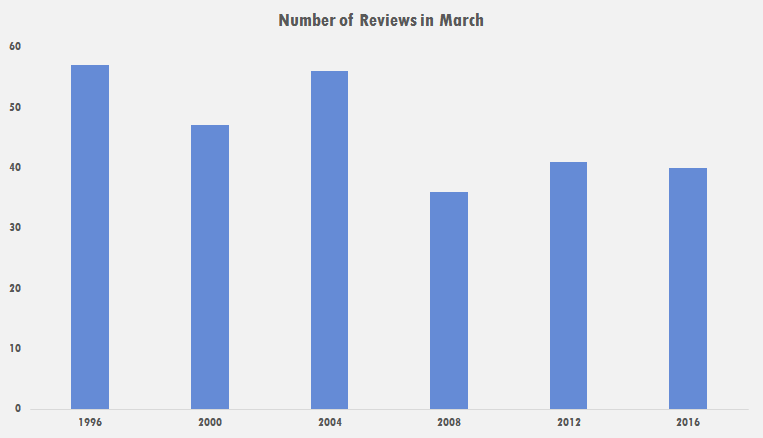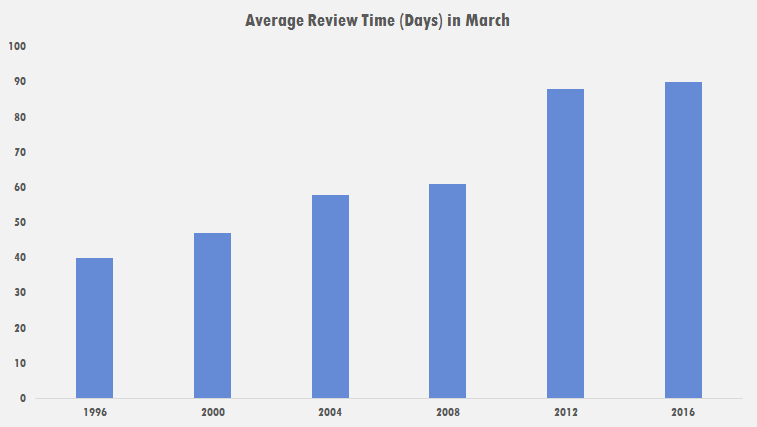Insight
April 11, 2016
Charting Midnight Regulation Before Dawn: Surge in Significant Rules
In its series tracking regulation in the final year of the Obama Administration, this month evidenced more of the same: little evidence of a rush in regulation, but steady stream of significant rulemaking. Last month, the White House approved 15 economically significant rulemakings (economic impact of $100 million or more). This month, that figure dropped to 10, but it was still more than any comparable March during a presidential election year since 1996. Through the first three months of this year, regulators have approved 31 significant rulemakings; the two next closest years were 2008 and 2004, when regulators approved just 22 significant rulemakings. In other words, the White House has approved 40 percent more significant regulatory action than any comparable period since 1996.
With less than a year for President Obama to regulate, this is his midnight year for regulation. Although it’s not the official midnight period yet (defined as the period after Election Day, but before the next president takes office), each month the American Action Forum (AAF) will highlight the final regulatory activity of the administration and compare it to similar times in the past. This monthly series will highlight all of the rules leaving the White House scheduled for official publication, all economically significant measures, the length of time for White House review, the number of rules rejected or withdrawn from the rulemaking process, and the monthly cost of federal regulatory activity.
March 2016
Once again, the aggregate regulatory output last month wasn’t notable. The Office of Information and Regulatory Affairs (OIRA), the branch of the White House in charge of reviewing cabinet-agency regulation, concluded review of 40 rules, down from 42 rules in February. In March 1996, by contrast, OIRA reviewed 57 rulemakings. The low point for March activity took place in 2008 when OIRA reviewed just 36 rules. The chart below tracks overall regulatory activity during these midnight years.
However, for economically significant measures, March 2016 blew away the field, as did the previous month this year. OIRA concluded review of 10 measures, double the amount from 2012, and 20 percent more than 2008. Below are some of the notable regulations released last month:
- Exposure to Silica;
- Sanitary Transportation of Human and Animal Food;
- Conservation Standards for Packaged Boilers; and
- Increasing Buprenorphine.
Despite the output of 10 significant measures, there are still 32 economically significant measures pending review (as of this writing), up from 26 measures last month, so agencies continue to pile up notable rulemakings at the White House. In March, OIRA received ten additional measures, including a rule for sound on hybrid vehicles and nondiscrimination provisions under the Affordable Care Act.
Once again, OIRA concluded review of several rules that had been under review for more than 120 days, which is the generally allowed timeframe for White House review under current executive orders. OIRA concluded review of 8 rulemakings that had been under review for more than 120 days, including “Child Nutrition Program Integrity,” which had been under review for 687 days.
March dwarfed other similar periods during presidential election years for average review times. The average review time this month was 90 days, compared to 88 in March of 2012. The next closest figure was 61 days during March 2008. For that year, the average review time is 93 days, compared to 63 days in 2008, and 74 days in 2000.
For comparison, the chart below tracks the average review time since 1996 during midnight years.
With regard to “withdrawn” rulemakings, or measures that agencies and OIRA pull back from review, there were none in March. In contrast, there were three withdrawn measures in 2012, seven withdrawn rules in 2004, and three in 1996. There is an obvious disincentive for agencies to withdraw rules this late during an administration and the White House has not aggressively pulled back regulations from review, at least compared to other similar periods.
The Cost
Thanks to AAF’s Reg Rodeo tool, the public can track regulatory costs and paperwork burdens over time, including data on major rules, Dodd-Frank, and the Affordable Care Act. In March 2016, regulators finalized $9.6 billion in costs, up from $5.6 billion in February, but down from $17.8 billion in costs from January. How does this compare to other similar periods? Although not a presidential election year, in March 2015, regulators published $1.1 billion in costs. In terms of paperwork, regulators published 3.3 million final hours in March, compared to March 2015, with 2.3 million hours.
Finally, there is the ultimate question of President Obama’s regulatory legacy. The Government Accountability Office keeps track of all major regulations. Through this point in his presidency, George W. Bush had issued 401 major rules. By contrast, President Obama has issued 578, or 44 percent more than his predecessor. AAF will continue to publish monthly updates comparing President Obama’s last days of regulation to other similar periods in history.












